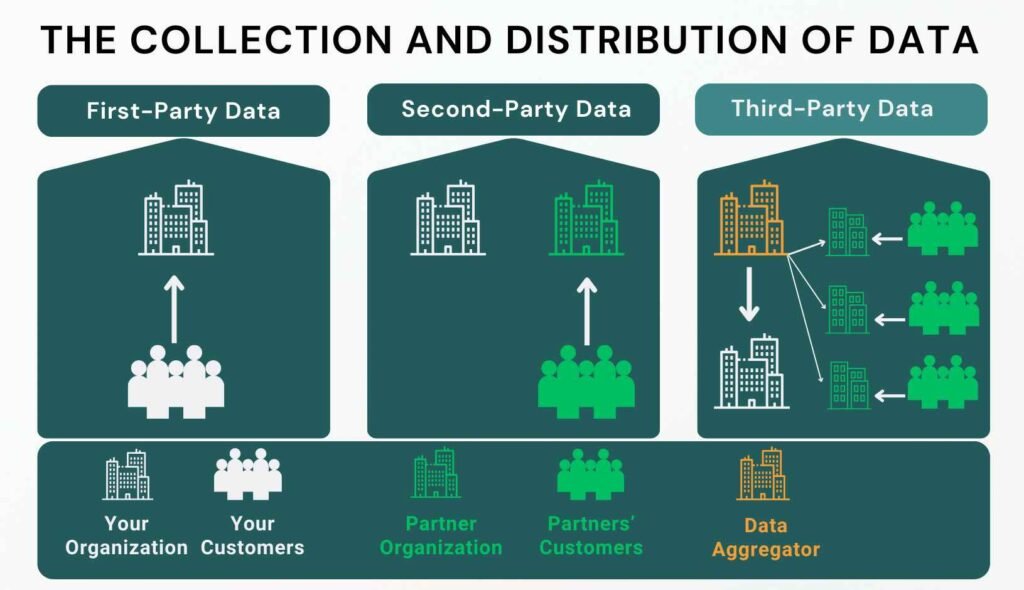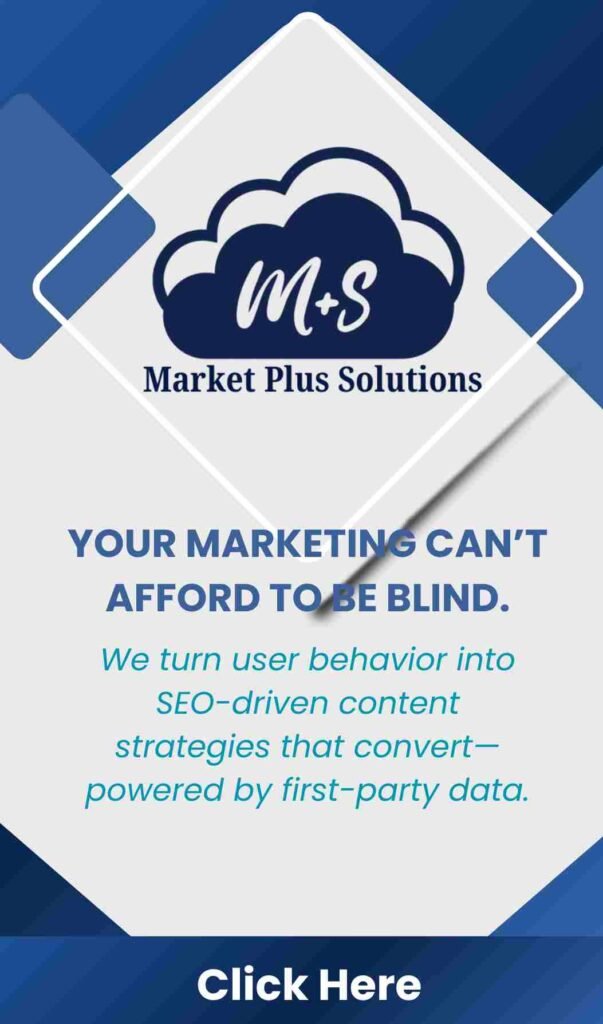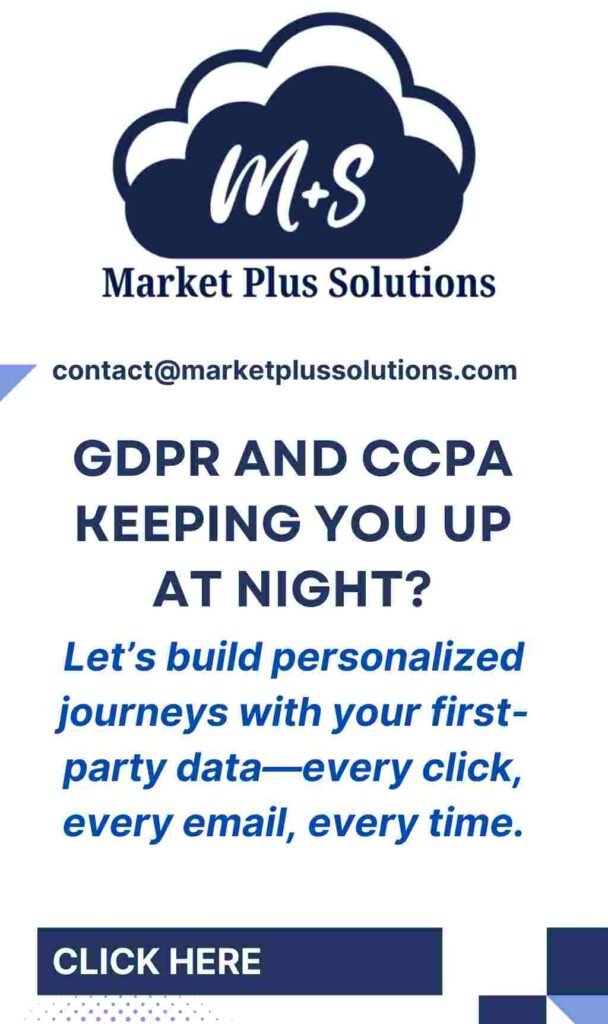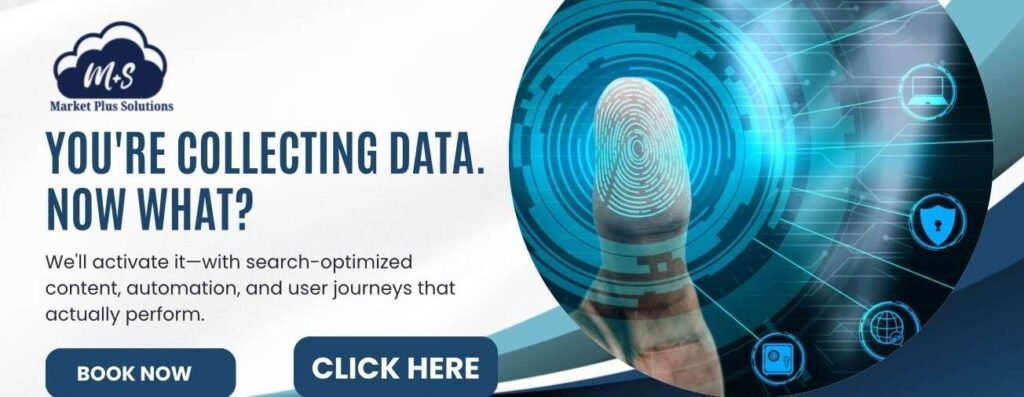What Is First-Party Data Marketing?
First-party data marketing is the strategic use of data you collect directly from your audience—through your website, mobile app, email campaigns, CRM systems, surveys, or how users interact with your product. This data forms the foundation for creating personalized, relevant marketing experiences that build trust and drive real performance.
Unlike third-party data—which is often purchased or gathered without direct user consent—first-party data is willingly shared. It’s earned through transparent, value-driven interactions. And that’s exactly why it’s becoming the backbone of privacy-first marketing and a key advantage in a cookieless, compliance-driven digital world.
By tapping into high-quality, consent-based insights, first-party data marketing helps you move beyond guesswork—and connect with your audience on their terms.
Understanding First-Party Data Marketing: Introduction
Marketing isn’t just evolving—it’s being rewritten.
With third-party cookies on the way out and global privacy regulations growing stricter by the year, relying on rented, external data sources is no longer a viable strategy. This is exactly why first-party data marketing has moved from optional to essential.
According to a 2024 Acquia CX Trends Report, 93% of marketers believe collecting first-party data is more critical than ever for an organization, emphasizing the importance of building trust through proper data handling.
(qrcodechimp)
Unlike third-party data, which is often bought or scraped from external platforms, first-party data is collected directly from your customers—through your website, product usage, CRM, surveys, and email interactions. It’s consent-based, accurate, and earned through real, meaningful engagement.
A well-executed first-party data strategy empowers marketers to target with precision, personalize content based on actual user behavior, and stay fully aligned with data protection laws like GDPR and CCPA. It also future-proofs your brand in a cookieless marketing world—where trust, transparency, and ethical data use are not just nice-to-haves, but expectations.
Bottom line?
If you want to connect with the right people, at the right time, with the right message—first-party data marketing is how you do it.

Why First-Party Data Marketing Is Booming in 2025
Let’s be clear: first-party data marketing isn’t just trending in 2025—it’s taking over. As marketers adjust to a landscape without third-party cookies and with stricter privacy laws, first-party data strategies are quickly becoming the only reliable way to deliver performance, personalization, and compliance at scale.
(See how our SEO solutions drive real results for small businesses like yours – click here)
Here’s why this shift is happening—and why it’s here to stay:
1. Third-Party Cookies Are Officially Dead
With Google Chrome joining Safari and Firefox in phasing out third-party cookies, marketers have lost a long-relied-on method for tracking users across the web. That means no more anonymous targeting, no more questionable data quality, and no more shortcuts.
First-party data marketing fills that gap by giving you access to clean, consented, real-time insights—straight from your audience, on your own platforms. No middlemen. No guesswork.
2. Privacy Laws Are Only Getting Tougher
Regulations like GDPR, CCPA, and other regional frameworks have made it crystal clear: user data must be collected, stored, and used responsibly. And the penalties for getting it wrong? Expensive—and reputation-damaging.
According to Tableau, 54% of consumers feel that companies fail to use their data in a way that benefits them—revealing a deep trust gap in how personal data is handled.
Unlike third-party data, first-party data is collected with transparency and permission. It’s traceable, verifiable, and built for privacy-first marketing from the ground up.
3. Today’s Customers Want Control and Relevance
Consumers aren’t against sharing data. They’re against being tracked without knowing it. They’re against irrelevant ads and blanket messaging. (If you’re looking for vertical SaaS Marketing Agencies, explore who you should partner with.)
A thoughtful first-party data strategy lets you deliver hyper-personalized experiences—while giving users complete control over what they share. That balance of value and respect is what turns one-time buyers into long-term loyalists.
4. Cookieless Marketing Demands Owned Data
In a cookieless future, whoever owns the data owns the advantage. With first-party data, you don’t rely on Facebook pixels or third-party platforms. You control the customer insights. You define the targeting. You drive the performance.
It’s the backbone of cookieless marketing and the key to building lasting relationships without compromising privacy. (Work only with the best SaaS SEO Service – explore more here.)
5. AI and Automation Thrive on First-Party Data
The best AI tools are only as good as the data you feed them. And first-party data is gold. From email automation and customer journey orchestration to predictive modeling and product recommendations—first-party data marketing powers smarter decisions at scale.
It allows marketers to move faster, test more precisely, and automate with confidence—without relying on external signals that may disappear tomorrow.
6. Rising Cost of Acquisition Is Forcing Efficiency
With ad platforms becoming more expensive and less predictable, marketers are under pressure to get more value from every click and impression. First-party data marketing reduces dependency on high-cost channels by increasing the efficiency of your owned media, email marketing, and CRM campaigns—where ROI is higher and customer insights are richer.
7. Ad Tech Platforms Are Prioritizing First-Party Integrations
Google, Meta, LinkedIn, and others are increasingly optimizing their ad tools around first-party data inputs. That means if you’re not bringing your own high-quality audience data to the table, your targeting options and campaign performance will suffer. (Needing SaaS Content Marketing Services, explore more here.)
Platforms are rewarding advertisers who use first-party data with better match rates, improved reach, and smarter lookalike modeling.
8. First-Party Data Supports Full-Funnel Marketing
It’s not just about acquisition. First-party data strategies allow you to support every stage of the funnel—onboarding, retention, upselling, and re-engagement. Because you own the insights, you can deliver consistent, relevant messaging throughout the customer lifecycle.
The Bottom Line? First-party data marketing isn’t just a privacy-friendly solution. It’s a performance-driven strategy. It gives you control, relevance, and long-term stability in an ecosystem that’s shifting fast. In 2025, the brands that own their insights—and their customer relationships—are the ones built to grow.

Strategies for Effective First-Party Data Collection
Let’s be honest—first-party data marketing isn’t about dropping a form on your homepage and calling it a day. It’s about building a thoughtful, ethical system that captures real insights across the customer journey—without breaking trust or compliance standards.
(Discover our SaaS SEO services built to help small businesses rank, grow, and convert).
Here’s how smart marketers are making first-party data collection work in 2025:
1. Use Smart Forms and Progressive Profiling
Don’t overload users on the first touch. Instead, use progressive profiling to collect data gradually as trust builds. With every form fill, download, or interaction, you learn more—without overwhelming the experience.
Tip: : Offer something valuable in return—exclusive content, early access, loyalty perks. Make every data request feel like a fair trade.
2. Turn Your Website into a Data Engine
Your website isn’t just a digital brochure—it’s your most powerful first-party data collection tool. Track key behaviors like page views, scroll depth, form fills, chat interactions, and product engagement. Tools like Google Tag Manager, Hotjar, and first-party analytics platforms make this easy and actionable.
Tip: Layer behavioral data with user-submitted info to create privacy-first marketing profiles that are both accurate and actionable.
3. Leverage CRM and Email Engagement
Your CRM is a goldmine—if you know how to use it. Every click, open, or reply is a signal of interest and intent. When connected to your email platform, CRM data helps you run smarter, first-party data marketing campaigns based on real customer behavior—not assumptions.
Tip: Segment audiences by lifecycle stage, engagement level, or interest to power hyper-personalized campaigns that actually convert.
4. Create Interactive Touchpoints
Quizzes, preference centers, calculators—these tools do more than engage users. They actively collect first-party data in a clear, compliant, and user-friendly way. The result? You gain insight, they gain value. Everybody wins.
Tip: Keep UX clean and consent messaging clear. Users should always know what data they’re sharing and why.
5. Incentivize with Real Value
If you’re asking for personal data, make it worth it. Whether it’s gated content, bonus features, or loyalty rewards, your value exchange must be obvious and compelling. No one hands over their information without a reason.
Tip: Be transparent. Tell users how their data will be used. Trust is currency—and it converts better than any lead magnet.
6. Invest in Consent Management and Governance
Compliance isn’t a side task—it’s part of your brand reputation. Use a consent management platform (CMP) to manage user permissions and stay aligned with GDPR, CCPA, and other evolving data privacy laws. Build your first-party data strategy on a foundation of clarity and control. (Explore more about ESG and Compliance here)
Tip: Ditch the legalese. Make your privacy policy human-readable and easy to access.
7. Use Preference Centers to Empower Users
A well-designed preference center lets users tell you exactly what they want—from content topics to communication frequency. It’s not just polite—it’s powerful. These preferences are a goldmine for first-party data marketing, helping you tailor experiences and boost engagement without guessing.
Tip: This also keeps your marketing compliant and relevant at the same time.
8. Collect Data Across Devices and Channels
Modern users switch between mobile, desktop, email, and app environments constantly. Use first-party data tools that unify these interactions under a single customer profile. This gives you a complete, cross-channel view of user behavior—perfect for data-driven personalization.
Tip: Invest in CDPs (Customer Data Platforms) or integrated marketing stacks that support omnichannel tracking and personalization.
9. Align Sales and Marketing Around Shared Data
Sales teams gather valuable first-party data in calls, demos, and CRM notes. When marketing and sales operate in silos, that data gets lost. By integrating systems and creating shared workflows, you make sure all customer signals are captured, synced, and acted on—no gaps, no guesswork.
Tip: Use this unified data to improve lead scoring, segmentation, and personalized follow-ups.

Ensuring Compliance in First-Party Data Usage
Collecting first-party data is only half the equation. How you store, manage, and use that data determines whether your strategy is legally sound—or a liability waiting to happen. With regulations like GDPR, CCPA, and the growing global focus on digital privacy, first-party data marketing must be built on a foundation of transparency and compliance.
(Visit our Content Marketing Page to see how we help small businesses succeed online.)
Here’s how to get it right:
Always Obtain Clear, Informed Consent:
Consent isn’t just a checkbox—it’s the starting point of trust. Whether you’re collecting data via web forms, surveys, or email interactions, users must understand:
- What data is being collected
- Why it’s being collected
- How it will be used
- How they can manage or revoke consent
Tip: A clear, user-friendly consent management platform (CMP) can automate much of this, ensuring your first-party data strategy aligns with legal requirements.
According to a 2023 Gartner survey, nearly 60% of marketing leaders reported increased difficulty in collecting first-party data while maintaining a balance between customer value and privacy—highlighting the growing complexity of compliant data strategies.
Implement Transparent Data Policies:
Your privacy policy shouldn’t read like a legal disclaimer. It should clearly explain how customer data is collected, stored, used, and protected. Transparency is a core principle of privacy-first marketing—and it’s one of the simplest ways to build user trust.
Tip: Regularly review and update your privacy documentation to stay aligned with changing regulations.
Give Users Control Over Their Data
Regulations like GDPR require that users can access, modify, or delete their data at any time. Make this process intuitive and easy. Preference centers are a great way to let users update their data, communication preferences, or unsubscribe altogether—without friction.
Tip: This isn’t just compliance—it’s good user experience.
Protect Data with Strong Governance and Security
If you’re collecting first-party data, you’re responsible for safeguarding it. That means working closely with IT and legal teams to:
- Encrypt personal data at rest and in transit
- Use role-based access controls
- Conduct regular audits of your data management processes
- Train your team on data privacy best practices
Tip: Security and governance are non-negotiable pillars of ethical first-party data marketing.
Avoid Data Creep and Overcollection
Just because you can collect certain data doesn’t mean you should. Be selective. Focus on collecting data that serves a clear purpose—enhancing personalization, improving customer experience, or driving data-driven personalization.
Tip: Collecting unnecessary or sensitive data without a valid reason can open you up to compliance risks and erode user trust.
Document Everything
From how consent was gathered to where data is stored, proper documentation protects your team and keeps your first-party data strategy audit-ready. Use data maps and audit trails to ensure every customer record is traceable and compliant. (Explore more about Transparency in Sustainability reporting here)
First-party data marketing works best when it’s not just effective, but ethical. By embedding compliance into every layer of your data collection and activation workflows, you protect your business and build stronger relationships with the people who matter most—your customers.
Privacy Compliance: More Than a Checkbox
For too long, privacy compliance has been treated as an afterthought—a checkbox to tick, a banner to display. But in 2025, that mindset isn’t just outdated—it’s risky. In the era of first-party data marketing, privacy compliance isn’t a formality. It’s a strategic advantage.
(Visit our SaaS Content Marketing Page to see how we help small businesses succeed online.)
Here’s why real compliance goes deeper—and how to build it into your first-party data strategy.
1. Regulations Are Evolving—and So Must You
Laws like GDPR, CCPA, and newer regional frameworks are reshaping how marketers operate. Consent must be explicit. Data usage must be transparent. And consumers must have full control over their information.
Means: First-party data marketing is naturally aligned with these principles—if you treat compliance as a core part of your strategy, not just a legal requirement.
2. Consent Isn’t Optional
Every point of first-party data collection—whether through a signup form, newsletter opt-in, or interactive quiz—must be backed by clear, informed consent. That means:
- No pre-checked boxes
- No vague language
- No buried terms and conditions
Means: A modern consent management platform (CMP) can help automate and track permissions while giving users the power to opt in—or out—on their own terms.
3. Transparency Builds Trust
You’re not just collecting data—you’re building a relationship. That starts with being honest about what data you’re gathering, why it matters, and how it enhances the user experience. Transparency is the foundation of both privacy-first marketing and long-term brand trust.
Means: Add user-friendly privacy notices to your forms, preference centers, and marketing communications.
In 2019 and again in 2022, the French data protection authority (CNIL) fined Google €50 million and €150 million respectively—first, for failing to provide transparent information and valid consent for personalized ads, and later, for making it unnecessarily difficult for users to refuse cookies. These penalties underscore the importance of clear consent mechanisms and proper handling of first-party data under GDPR.
4. Make Opt-Out Easy (And Visible)
If users can’t find your unsubscribe button—or if they need a degree to understand your data policy—you’ve already lost them. Compliance requires frictionless data access, deletion, and preference management.
Means: Empower users with real control. It’s not just regulation—it’s respect.
5. Secure What You Collect
With rising cyber threats, collecting first-party data comes with responsibility. Ensure robust data governance: encryption, role-based access, regular audits, and breach response protocols. (Explore more about our company here)
Means: Your first-party data strategy is only as strong as your security posture.
6. Treat Compliance as Customer Experience
At its best, privacy-first marketing doesn’t feel like compliance—it feels like personalization done right. When users see that their data is handled ethically and used to deliver value, they’re more likely to engage, convert, and stay loyal.
Means: Privacy compliance isn’t a checkbox—it’s a brand promise. And in a world where trust is currency, your approach to first-party data marketing could be your biggest differentiator.
Final Thoughts – Looking Ahead: First-Party Data Is the Future
The way we approach marketing is being rewritten.
(Explore the industries we serve here)
Third-party cookies are vanishing – Privacy laws are tightening – And consumers are demanding transparency like never before. In this environment, first-party data marketing isn’t just the smart play—it’s the only sustainable one.
As we look ahead, it’s clear: brands that prioritize privacy-first marketing, build strong consent-driven first-party data strategies, and use that data to deliver relevant, respectful experiences will have the upper hand. This isn’t just about compliance—it’s about building a long-term competitive advantage.
What This Means for Marketers:
- Stop renting audiences. Start owning relationships.
- Build cookieless marketing workflows that work for both your business and your users.
- Use first-party data to personalize, automate, and optimize every touchpoint—ethically.
- Future-proof your tech stack with consent management, customer data platforms (CDPs), and AI tools powered by real, high-quality data.
In the end, first-party data marketing is more than a tactic. It’s a mindset—a commitment to trust, relevance, and long-term value. The sooner your organization embraces it, the stronger your position will be in a market defined by user control and data transparency.
Don’t wait for the future of marketing to arrive. Start building it now—with first-party data.




